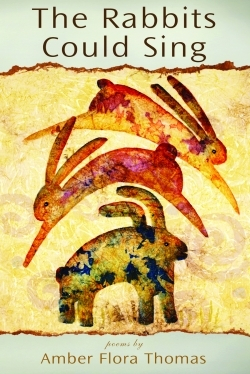The Rabbits Could Sing
Time spent in nature provides an opportunity to decompress, put aside the iPhones and Blackberrys, and reflect on aspects of life that often get pushed aside. In The Rabbits Could Sing, her second book of poetry, Amber Flora Thomas uses her own time in nature not just to reflect on her interactions with nature itself, but also as a launching point and measure of comparison for other topics.
The rabbits do indeed sing, in the form of Thomas’s verse; rabbits are the subject of the poems “Killing the Rabbit: Ars Poetica,” “The Killed Rabbit,” and “Hare in My Garden,” which together form a compelling triptych of human interactions with nature. The verses in these three poems move from an unsuccessful lesson in objectifying the victim, to documenting the rabbit’s cold acceptance of its fate, to a compassionate acknowledgement of lessons learned and a rabbit freed.
In “The Killed Rabbit” Thomas writes: “Its eye assumes a transfixed nature while gazing / at black plastic lining a bucket. Displaced / in all that is held there, vision / is in fact a reckless understanding.” Other poems invoke spiders, birds, bees, and ants, but always cast a wider net than those simple beginnings might imply. In “Bull Frog” Thomas relates a tender definition of love: “I suspect love is like the water’s trickle from a drainage pipe / at the pool’s edge, never quite full of its seepage.”
The occasional interjection of decidedly non-natural settings (most notably a hospital) is jarring, but the contrast helps to place the coldness and isolation of such sterile environments into a larger context.
Amber Flora Thomas has won several prizes for her poetry, including the Dylan Thomas American Poet Prize, Richard Peterson Prize, and Ann Stanford Prize. Her first book*, Eye of Water: Poems* won the Cave Canem prize. With The Rabbits Could Sing, Amber Flora Thomas continues her upward arc in the world of poetry, and it would be surprising if awards did not follow for this volume as well. Readers of modern poetry and lovers of nature should find much to enjoy in this collection, wherein the rabbits sing, and they sing beautifully.
Reviewed by
Peter Dabbene
Disclosure: This article is not an endorsement, but a review. The publisher of this book provided free copies of the book and paid a small fee to have their book reviewed by a professional reviewer. Foreword Reviews and Clarion Reviews make no guarantee that the publisher will receive a positive review. Foreword Magazine, Inc. is disclosing this in accordance with the Federal Trade Commission’s 16 CFR, Part 255.

